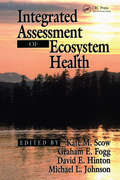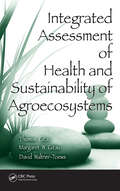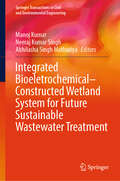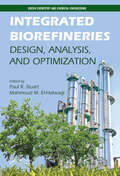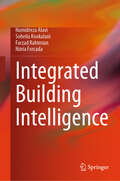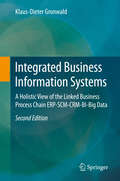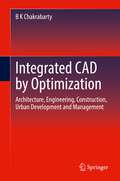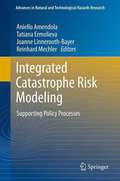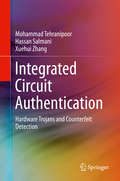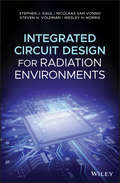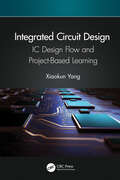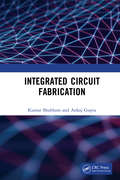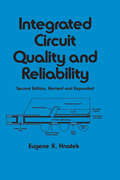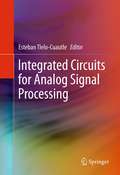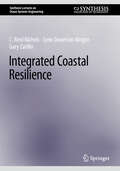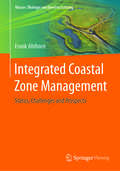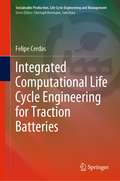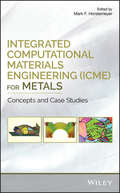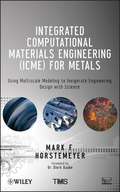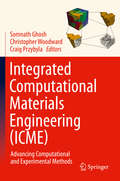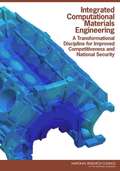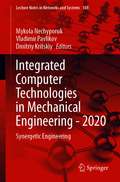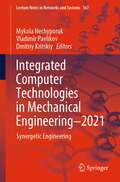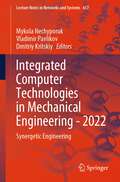- Table View
- List View
Integrated Assessment of Ecosystem Health
by K ate M. Scow Graham E. Fogg David E. H Inton Michael L. JohnsonThe new approach to ecosystem health is proactive. As a result, the scope of environmental studies is growing and the methods are evolving. Integrated Assessment of Ecosystem Health aggressively broadens the range of ecotoxicology to include its related fields.The book begins with John Cairns, Jr.'s predictions and recommendations for the futur
Integrated Assessment of Health and Sustainability of Agroecosystems (Advances in Agroecology)
by David Waltner-Toews Thomas Gitau Margaret W. GitauExploring the implementation of participatory, multistakeholder, and transdisciplinary ecosystem health research, Integrated Assessment of Health and Sustainability of Agroecosystems combines the latest theories in complexity and management with practical tools and approaches for sustainable rural development research.Although the text foc
Integrated Bioeletrochemical–Constructed Wetland System for Future Sustainable Wastewater Treatment (Springer Transactions in Civil and Environmental Engineering)
by Manoj Kumar Neeraj Kumar Singh Abhilasha Singh MathuriyaThis book provides latest information and knowledge from internationally recognized experts working in wastewater treatment field. It covers broad aspects of integrated bioeletrochemical-constructed wetland system for future sustainable wastewater treatment and resource recovery. It discusses various constructed wetland and their application in wastewater treatment and the principle and mechanism of bioelectrochemical system for wastewater treatment. The book also reviews the various types of constructed wetland integrated with bioeletrochemical and microbial fuel cells. It includes chapters on the recovery of bioelectricity and bioenergy from wastewater resource using constructed wetland by adoption of microbial fuel cell technology, recent advancements in bioelectrochemical system and microbial fuel cell technology for energy production in constructed wetland, applied bioaugmentation and bioremediation treatment technology in constructed wetland for wastewater treatment, successful models of constructed wetlands applied for water purification across the globe, and chapters on scaling up, economic sustainability, and feasibility and life cycle assessment of constructed wetland for wastewater treatment integrated with microbial fuel cells and bioelectrochemical systems. The book can be a valuable reference for researchers and professionals interested in wastewater treatment and allied fields.
Integrated Biorefineries: Design, Analysis, and Optimization (Green Chemistry and Chemical Engineering)
by Mahmoud M. El-Halwagi Paul R. StuartIntegrated Biorefineries: Design, Analysis, and Optimization examines how to create a competitive edge in biorefinery innovation through integration into existing processes and infrastructure. Leading experts from around the world working in design, synthesis, and optimization of integrated biorefineries present the various aspects of this complex
Integrated Building Intelligence
by Hamidreza Alavi Soheila Kookalani Farzad Rahimian Núria ForcadaThis book integrates of Building Information Modeling (BIM) and Decision Support Systems (DSS) in the field of building design, construction, and maintenance. The book explores how BIM and DSS technologies can be synergistically utilized to enhance performance, comfort, and maintenance efficiency in buildings. With an emphasis on practical applications, the book provides a comprehensive overview of the latest advancements in BIM and DSS, including real-world case studies and implementation guidelines. The book features illustrations, tables, and examples that aid in understanding complex concepts and demonstrate the practical application of BIM and DSS in building projects. Readers will gain a deep understanding of how BIM and DSS can be integrated to optimize building design, streamline construction processes, and improve facility management and maintenance. The main benefit of reading this book is that it provides a valuable resource for professionals in the architecture, engineering, and construction industries who want to leverage the power of BIM and DSS to enhance their building projects. Additionally, the book explores how BIM and DSS can contribute to energy efficiency.
Integrated Business Information Systems: A Holistic View of the Linked Business Process Chain ERP-SCM-CRM-BI-Big Data
by Klaus-Dieter GronwaldEnterprise Resource Planning (ERP), Supply Chain Management (SCM), Customer Relationship Management (CRM), Business Intelligence (BI) and Big Data analytics (BDA) are business related tasks and processes, which are supported by standardized software solutions. The book explains that this requires business-oriented thinking and acting from IT specialists and data scientists. It is a good idea to let students experience this directly from the business perspective, for example as executives of a virtual company in a role-playing game. The second edition of the book has been completely revised, restructured and supplemented with actual topics such as blockchains in supply chains and the correlation between Big Data analytics, artificial intelligence and machine learning. The structure of the book is based on the gradual implementation and integration of the respective information systems from the business and management perspectives. Part I contains chapters with detailed descriptions of the topics supplemented by online tests and exercises. Part II introduces role play and the online gaming and simulation environment. Supplementary teaching material, presentations, templates, and video clips are available online in the gaming area. The gaming and business simulation Kdibisglobal.com, newly created for this book, now includes a beer division, a bottled water division, a soft drink division and a manufacturing division for barcode cash register scanner with their specific business processes and supply chains.
Integrated CAD by Optimization: Architecture, Engineering, Construction, Urban Development and Management
by B K ChakrabartyThis book presents range of topics concerning integrated CAD (including Optimization) for use in Architecture (including Planning), Civil Engineering and Construction (AEC), and thus, helps introduce a full-length treatment of the subject, enabling practitioners to adopt an Integrated Computer-Aided Design Approach in their professional activity. The book gives to readers an understanding of the main elements of CAD, highlighting the importance of integrating these elements and the applicability of Integrated CAD in AEC. Many examples and problems (including Optimization) are included to help professionals and students to develop and apply such tools in solving problems in AEC field. Adopts a problem solving approach in planning, design, and management stressing IT and Computer Application in AEC sector as a whole;Emphasizes resource-efficiency and social equity in problem solution in the AEC sector in general, and in urban development and management in particular;Stresses optimization and an integrated approach covering all components, including costs, affordability and environmental factors, scarcity of resources, and resolution of conflicting interests;Includes an accessible overview and source codes of C++ and Auto Lisp programs needed to carry out design analysis, optimization and drafting-drawing in an integrated manner.
Integrated Catastrophe Risk Modeling: Supporting Policy Processes
by Tatiana Ermolieva Aniello Amendola Reinhard Mechler Joanne Linnerooth-BayerEfficient and equitable policies for managing disaster risks and adapting to global environmental change are critically dependent on development of robust options supported by integrated modeling. The book is based on research and state-of-the art models developed at IIASA (International Institute for Applied Systems Analysis) and within its cooperation network. It addresses the methodological complexities of assessing disaster risks, which call for stochastic simulation, optimization methods and economic modeling. Furthermore, it describes policy frameworks for integrated disaster risk management, including stakeholder participation facilitated by user-interactive decision-support tools. Applications and results are presented for a number of case studies at different problem scales and in different socio-economic contexts, and their implications for loss sharing policies and economic development are discussed. Among others, the book presents studies for insurance policies for earthquakes in the Tuscany region in Italy and flood risk in the Tisza river basin in Hungary. Further, it investigates the economic impact of natural disasters on development and possible financial coping strategies; and applications are shown for selected South Asian countries. The book is addressed both to researchers and to organizations involved with catastrophe risk management and risk mitigation policies.
Integrated Catastrophe Risk Modeling: Supporting Policy Processes (Advances in Natural and Technological Hazards Research #32)
by Tatiana Ermolieva Aniello Amendola Reinhard Mechler Joanne Linnerooth-BayerEfficient and equitable policies for managing disaster risks and adapting to global environmental change are critically dependent on development of robust options supported by integrated modeling. The book is based on research and state-of-the art models developed at IIASA (International Institute for Applied Systems Analysis) and within its cooperation network. It addresses the methodological complexities of assessing disaster risks, which call for stochastic simulation, optimization methods and economic modeling. Furthermore, it describes policy frameworks for integrated disaster risk management, including stakeholder participation facilitated by user-interactive decision-support tools. Applications and results are presented for a number of case studies at different problem scales and in different socio-economic contexts, and their implications for loss sharing policies and economic development are discussed. Among others, the book presents studies for insurance policies for earthquakes in the Tuscany region in Italy and flood risk in the Tisza river basin in Hungary. Further, it investigates the economic impact of natural disasters on development and possible financial coping strategies; and applications are shown for selected South Asian countries. The book is addressed both to researchers and to organizations involved with catastrophe risk management and risk mitigation policies.
Integrated Circuit Authentication
by Mohammad Tehranipoor Hassan Salmani Xuehui ZhangThis book describes techniques to verify the authenticity of integrated circuits (ICs). It focuses on hardware Trojan detection and prevention and counterfeit detection and prevention. The authors discuss a variety of detection schemes and design methodologies for improving Trojan detection techniques, as well as various attempts at developing hardware Trojans in IP cores and ICs. While describing existing Trojan detection methods, the authors also analyze their effectiveness in disclosing various types of Trojans, and demonstrate several architecture-level solutions.
Integrated Circuit Design for Radiation Environments
by Steven H. Voldman Stephen J. Gaul Nicolaas van Vonno Wesley H. MorrisA practical guide to the effects of radiation on semiconductor components of electronic systems, and techniques for the designing, laying out, and testing of hardened integrated circuits This book teaches the fundamentals of radiation environments and their effects on electronic components, as well as how to design, lay out, and test cost-effective hardened semiconductor chips not only for today’s space systems but for commercial terrestrial applications as well. It provides a historical perspective, the fundamental science of radiation, and the basics of semiconductors, as well as radiation-induced failure mechanisms in semiconductor chips. Integrated Circuits Design for Radiation Environments starts by introducing readers to semiconductors and radiation environments (including space, atmospheric, and terrestrial environments) followed by circuit design and layout. The book introduces radiation effects phenomena including single-event effects, total ionizing dose damage and displacement damage) and shows how technological solutions can address both phenomena. Describes the fundamentals of radiation environments and their effects on electronic components Teaches readers how to design, lay out and test cost-effective hardened semiconductor chips for space systems and commercial terrestrial applications Covers natural and man-made radiation environments, space systems and commercial terrestrial applications Provides up-to-date coverage of state-of-the-art of radiation hardening technology in one concise volume Includes questions and answers for the reader to test their knowledge Integrated Circuits Design for Radiation Environments will appeal to researchers and product developers in the semiconductor, space, and defense industries, as well as electronic engineers in the medical field. The book is also helpful for system, layout, process, device, reliability, applications, ESD, latchup and circuit design semiconductor engineers, along with anyone involved in micro-electronics used in harsh environments.
Integrated Circuit Design: IC Design Flow and Project-Based Learning
by Xiaokun YangThis textbook seeks to foster a deep understanding of the field by introducing the industry integrated circuit (IC) design flow and offering tape-out or pseudo tape-out projects for hands-on practice, facilitating project-based learning (PBL) experiences.Integrated Circuit Design: IC Design Flow and Project-Based Learning aims to equip readers for entry-level roles as IC designers in the industry and as hardware design researchers in academia. The book commences with an overview of the industry IC design flow, with a primary focus on register-transfer level (RTL) design, the automation of simulation and verification, and system-on-chip (SoC) integration. To build connections between RTL design and physical hardware, FPGA (field-programmable gate array) synthesis and implementation is utilized to illustrate the hardware description and performance evaluation. The second objective of this book is to provide readers with practical, hands-on experience through tape-out or pseudo tape-out experiments, labs, and projects. These activities are centered on coding format, industry design rules (synthesizable Verilog designs, clock domain crossing, etc.), and commonly-used bus protocols (arbitration, handshaking, etc.), as well as established design methodologies for widely-adopted hardware components, including counters, timers, finite state machines (FSMs), I2C, single/dual-port and ping-pong buffers/register files, FIFOs, floating-point units (FPUs), numerical hardware (Fourier transform, matrix-matrix multiplication, etc.), direct memory access (DMA), image processing designs, neural networks, and more.The textbook caters to a diverse readership, including junior and senior undergraduate students, as well as graduate students pursuing degrees in electrical engineering, computer engineering, computer science, and related fields. The target audience is expected to have a basic understanding of Boolean Algebra and Karnaugh Maps, as well as prior familiarity with digital logic components such as AND/OR gates, latches, and flip-flops. The book will also be useful for entry-level RTL designers and verification engineers who are embarking on their journey in application-specific IC (ASIC) and FPGA design industry.
Integrated Circuit Fabrication
by Kumar Shubham Ankaj GuptaThis book covers theoretical and practical aspects of all major steps in the fabrication sequence. This book can be used conveniently in a semester length course on integrated circuit fabrication. This text can also serve as a reference for practicing engineer and scientist in the semiconductor industry. IC Fabrication are ever demanding of technology in rapidly growing industry growth opportunities are numerous. A recent survey shows that integrated circuit currently outnumber humans in UK, USA, India and China. The spectacular advances in the development and application of integrated circuit technology have led to the emergence of microelectronic process engineering as an independent discipline. Integrated circuit fabrication text books typically divide the fabrication sequence into a number of unit processes that are repeated to form the integrated circuit. The effect is to give the book an analysis flavor: a number of loosely related topics each with its own background material.Note: T& F does not sell or distribute the Hardback in India, Pakistan, Nepal, Bhutan, Bangladesh and Sri Lanka.
Integrated Circuit Quality and Reliability (Electrical and Computer Engineering)
by Eugene R. HnatekExamines all important aspects of integrated circuit design, fabrication, assembly and test processes as they relate to quality and reliability. This second edition discusses in detail: the latest circuit design technology trends; the sources of error in wafer fabrication and assembly; avenues of contamination; new IC packaging methods; new in-line process monitors and test structures; and more.;This work should be useful to electrical and electronics, quality and reliability, and industrial engineers; computer scientists; integrated circuit manufacturers; and upper-level undergraduate, graduate and continuing-education students in these disciplines.
Integrated Circuits for Analog Signal Processing
by Esteban Tlelo-CuautleThis book presents theory, design methods and novel applications for integrated circuits for analog signal processing. The discussion covers a wide variety of active devices, active elements and amplifiers, working in voltage mode, current mode and mixed mode. This includes voltage operational amplifiers, current operational amplifiers, operational transconductance amplifiers, operational transresistance amplifiers, current conveyors, current differencing transconductance amplifiers, etc. Design methods and challenges posed by nanometer technology are discussed and applications described, including signal amplification, filtering, data acquisition systems such as neural recording, sensor conditioning such as biomedical implants, actuator conditioning, noise generators, oscillators, mixers, etc. Presents analysis and synthesis methods to generate all circuit topologies from which the designer can select the best one for the desired application; Includes design guidelines for active devices/elements with low voltage and low power constraints;Offers guidelines for selecting the right active devices/elements in the design of linear and nonlinear circuits;Discusses optimization of the active devices/elements for process and manufacturing issues of nanometer technology.
Integrated Coastal Resilience (Synthesis Lectures on Ocean Systems Engineering)
by C. Reid Nichols Lynn Donelson Wright Gary ZarilloThe potential for natural hazards and vulnerability to these threats varies from community to community. Adaptation will require ongoing monitoring of the natural and built-up environments and the development of policies, structures, and approaches to ensure resilient communities. Resilient approaches involve assessing risk and vulnerability, identifying solutions to reduce risks, implementing viable solutions, and assessment. Owing to past damages from extreme weather, countries around the world are making significant investments in coastal infrastructure that will reduce risks from disasters that are exacerbated by climatic changes.
Integrated Coastal Zone Management: Status, Challenges and Prospects (Wasser: Ökologie und Bewirtschaftung)
by Frank AhlhornThe Book gives an overview about the Integrated Coastal Zone Management and offers examples and best practice. The focus is set on European coastal zones, worldwide and historical developements are considered also. Questons at the end of each chapter enable the consolidation of the matter.
Integrated Computational Life Cycle Engineering for Traction Batteries (Sustainable Production, Life Cycle Engineering and Management)
by Felipe CerdasThe environmental burden caused by private transportation represents a significant challenge towards sustainability. Electric vehicles are considered a key technology to reduce the environmental impact caused by the mobility sector. However, the global adoption of electromobility implies shift and diversification of the environmental impacts caused by the transportation sector mainly driven by the production of the battery system. Modeling the life cycle environmental impacts of traction batteries is a time demanding and interdisciplinary task as it involves a high variability and requires an in-depth knowledge of the product system under analysis. To face these challenges, an Integrated Computational Life Cycle Engineering ICLCE framework for EVs has been developed. The ICLCE framework described aims at supporting fast and comprehensive modelling of complex foreground systems in the electromobility field and their interaction with diverse backgrounds and partial contexts.
Integrated Computational Materials Engineering (ICME) for Metals: Concepts and Case Studies
by Mark F. HorstemeyerFocuses entirely on demystifying the field and subject of ICME and provides step-by-step guidance on its industrial application via case studies This highly-anticipated follow-up to Mark F. Horstemeyer’s pedagogical book on Integrated Computational Materials Engineering (ICME) concepts includes engineering practice case studies related to the analysis, design, and use of structural metal alloys. A welcome supplement to the first book—which includes the theory and methods required for teaching the subject in the classroom—Integrated Computational Materials Engineering (ICME) For Metals: Concepts and Case Studies focuses on engineering applications that have occurred in industries demonstrating the ICME methodologies, and aims to catalyze industrial diffusion of ICME technologies throughout the world. The recent confluence of smaller desktop computers with enhanced computing power coupled with the emergence of physically-based material models has created the clear trend for modeling and simulation in product design, which helped create a need to integrate more knowledge into materials processing and product performance. Integrated Computational Materials Engineering (ICME) For Metals: Case Studies educates those seeking that knowledge with chapters covering: Body Centered Cubic Materials; Designing An Interatomic Potential For Fe-C Alloys; Phase-Field Crystal Modeling; Simulating Dislocation Plasticity in BCC Metals by Integrating Fundamental Concepts with Macroscale Models; Steel Powder Metal Modeling; Hexagonal Close Packed Materials; Multiscale Modeling of Pure Nickel; Predicting Constitutive Equations for Materials Design; and more. Presents case studies that connect modeling and simulation for different materials' processing methods for metal alloys Demonstrates several practical engineering problems to encourage industry to employ ICME ideas Introduces a new simulation-based design paradigm Provides web access to microstructure-sensitive models and experimental database Integrated Computational Materials Engineering (ICME) For Metals: Case Studies is a must-have book for researchers and industry professionals aiming to comprehend and employ ICME in the design and development of new materials.
Integrated Computational Materials Engineering (ICME) for Metals: Using Multiscale Modeling to Invigorate Engineering Design with Science, 1st Edition
by Mark F. HorstemeyerState-of-the-technology tools for designing, optimizing, and manufacturing new materials Integrated computational materials engineering (ICME) uses computational materials science tools within a holistic system in order to accelerate materials development, improve design optimization, and unify design and manufacturing. Increasingly, ICME is the preferred paradigm for design, development, and manufacturing of structural products. Written by one of the world's leading ICME experts, this text delivers a comprehensive, practical introduction to the field, guiding readers through multiscale materials processing modeling and simulation with easy-to-follow explanations and examples. Following an introductory chapter exploring the core concepts and the various disciplines that have contributed to the development of ICME, the text covers the following important topics with their associated length scale bridging methodologies: Macroscale continuum internal state variable plasticity and damage theory and multistage fatigue Mesoscale analysis: continuum theory methods with discrete features and methods Discrete dislocation dynamics simulations Atomistic modeling methods Electronics structures calculations Next, the author provides three chapters dedicated to detailed case studies, including "From Atoms to Autos: A Redesign of a Cadillac Control Arm," that show how the principles and methods of ICME work in practice. The final chapter examines the future of ICME, forecasting the development of new materials and engineering structures with the help of a cyberinfrastructure that has been recently established. Integrated Computational Materials Engineering (ICME) for Metals is recommended for both students and professionals in engineering and materials science, providing them with new state-of-the-technology tools for selecting, designing, optimizing, and manufacturing new materials. Instructors who adopt this text for coursework can take advantage of PowerPoint lecture notes, a questions and solutions manual, and tutorials to guide students through the models and codes discussed in the text.
Integrated Computational Materials Engineering (ICME): Advancing Computational and Experimental Methods
by Christopher Woodward Somnath Ghosh Craig PrzybylaThis book introduces research advances in Integrated Computational Materials Engineering (ICME) that have taken place under the aegis of the AFOSR/AFRL sponsored Center of Excellence on Integrated Materials Modeling (CEIMM) at Johns Hopkins University. Its author team consists of leading researchers in ICME from prominent academic institutions and the Air Force Research Laboratory. The book examines state-of-the-art advances in physics-based, multi-scale, computational-experimental methods and models for structural materials like polymer-matrix composites and metallic alloys. The book emphasizes Ni-based superalloys and epoxy matrix carbon-fiber composites and encompasses atomistic scales, meso-scales of coarse-grained models and discrete dislocations, and micro-scales of poly-phase and polycrystalline microstructures. Other critical phenomena investigated include the relationship between microstructural morphology, crystallography, and mechanisms to the material response at different scales; methods of identifying representative volume elements using microstructure and material characterization, and robust deterministic and probabilistic modeling of deformation and damage. Encompassing a slate of topics that enable readers to comprehend and approach ICME-related issues involved in predicting material performance and failure, the book is ideal for mechanical, civil, and aerospace engineers, and materials scientists, in in academic, government, and industrial laboratories.
Integrated Computational Materials Engineering: A Transformational Discipline for Improved Competitiveness and National Security
by National Research Council of the National AcademiesIntegrated computational materials engineering (ICME) is an emerging discipline that can accelerate materials development and unify design and manufacturing. Developing ICME is a grand challenge that could provide significant economic benefit. To help develop a strategy for development of this new technology area, DOE and DoD asked the NRC to explore its benefits and promises, including the benefits of a comprehensive ICME capability; to establish a strategy for development and maintenance of an ICME infrastructure, and to make recommendations about how best to meet these opportunities. This book provides a vision for ICME, a review of case studies and lessons learned, an analysis of technological barriers, and an evaluation of ways to overcome cultural and organizational challenges to develop the discipline.
Integrated Computer Technologies in Mechanical Engineering - 2020: Synergetic Engineering (Lecture Notes in Networks and Systems #188)
by Mykola Nechyporuk Vladimir Pavlikov Dmitriy KritskiyThis book addresses conference topics such as information technology in the design and manufacture of engines; information technology in the creation of rocket space systems; aerospace engineering; transport systems and logistics; big data and data science; nano-modeling; artificial intelligence and smart systems; networks and communication; cyber-physical systems and IoE; and software engineering and IT infrastructure. The International Scientific and Technical Conference “Integrated Computer Technologies in Mechanical Engineering” – Synergetic Engineering (ICTM) was formed to bring together outstanding researchers and practitioners in the field of information technology, and whose work involves the design and manufacture of engines, creation of rocket space systems, and aerospace engineering, from all over the world to share their experiences and expertise. It was established by the National Aerospace University “Kharkiv Aviation Institute.” The ICTM’2020 conference was held in Kharkiv, Ukraine on October 28–30, 2020.
Integrated Computer Technologies in Mechanical Engineering - 2021: Synergetic Engineering (Lecture Notes in Networks and Systems #367)
by Mykola Nechyporuk Vladimir Pavlikov Dmitriy KritskiyThe International Scientific and Technical Conference “Integrated Computer Technologies in Mechanical Engineering” – Synergetic Engineering (ICTM) was established by National Aerospace University “Kharkiv Aviation Institute”. The Conference ICTM’2021 was held in Kharkiv, Ukraine, during October 28–29, 2021. During this conference, technical exchanges between the research community were carried out in the forms of keynote speeches, panel discussions, as well as special session. In addition, participants were treated to a series of receptions, which forge collaborations among fellow researchers. ICTM’2021 received 203 papers submissions from different countries. Target Groups ICTM was formed to bring together outstanding researchers and practitioners in the field of information technology in the design and manufacture of engines; creation of rocket space systems, aerospace engineering from all over the world to share their experience and expertise.
Integrated Computer Technologies in Mechanical Engineering - 2022: Synergetic Engineering (Lecture Notes in Networks and Systems #657)
by Mykola Nechyporuk Vladimir Pavlikov Dmitriy KritskiyThe International Scientific and Technical Conference “Integrated Computer Technologies in Mechanical Engineering”—Synergetic Engineering (ICTM) was established by National Aerospace University “Kharkiv Aviation Institute.” The Conference ICTM’2022 was held in Kharkiv, Ukraine, during November 18–20, 2022. During this conference, technical exchanges between the research community were carried out in the forms of keynote speeches, panel discussions, as well as special session. In addition, participants were treated to a series of receptions, which forge collaborations among fellow researchers. ICTM’2022 received 137 papers submissions from different countries. All of these offer us plenty of valuable information and would be of great benefit to experience exchange among scientists in modeling and simulation. The organizers of ICTM’2022 made great efforts to ensure the success of this conference. We hereby would like to thank all the members of ICTM’2022 Advisory Committee for their guidance and advice, the members of program committee and organizing committee, and the referees for their effort in reviewing and soliciting the papers, and all authors for their contribution to the formation of a common intellectual environment for solving relevant scientific problems. Also, we grateful to Springer—Janusz Kacprzyk and Thomas Ditzinger as the editor responsible for the series “Lecture Notes in Networks and Systems” for their great support in publishing these selected papers.
